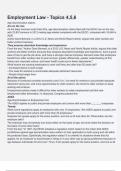Employment Law - Topics 4,5,6
Age discrimination claims:
Are on the rise
As the baby boomers enter their 60's, age discrimination claims filed with the EEOC are on the rise,
with 22,857 persons in 2012 making age-related complaints with the EEOC, compared with 16,548 in
2006.
Author Dave Bernard, in a 2012 U.S. News and World Report article, argues that older workers are
better workers because:
They possess abundant knowledge and experience
From the text, "Author Dave Bernard, in a 2012 U.S. News and World Report article, argues that older
workers are better workers because they possess abundant knowledge and experience, have a good
idea of how to get the job done, and have a stronger internal compass. Bernard notes that employers
benefit from older workers due to less turnover, greater efficiencies, greater understanding of firm
history and corporate culture, and lower health costs due to fewer dependents."
What factors are causing employees to work until they are older than 55 years old?
--Increased desire to work longer
--The need for workers to accumulate adequate retirement resources
--People living longer lives
All of the above
100%
Because of continued uncertain economic conditions, the need for workers to accumulate adequate
retirement resources, and more opportunities for older workers, the trend for older workers to keep
working will continue.
Employment policies made it difficult for older workers to retain employment and find new
employment after termination. In response, Congress passed the:
ADEA
Age Discrimination in Employment Act
The ADEA applies to public and private employers and unions with more than _______ employees.
Twenty
While some regulations apply to employers with only 15 employees, "the ADEA applies to public and
private employers and unions with more than 20 employees."
Suppose two people apply for the same position, and one is 42 and other 52. What action can the
employer take?
The employer may not lawfully turn down either on the basis of age, but must make the decision on
the basis of some other factor
From the text, "In 1981, the EEOC adopted a regulation which rested on the notion that ADEA
prohibitions against age discrimination were uniform in their application to both young and old within
the protected class. Specifically, the regulation stated "it is unlawful in situations where this Act
applies, for an employer to discriminate in hiring or in any other way by giving preference because of
age between individuals 40 and over." Thus, if two people apply for the same position, and one is 42
, and the other 52, the employer may not lawfully turn down either on the basis of age, but must make
such decisions on the basis of some other factor."
How old must an employee be to claim age discrimination under the ADEA?
Must be over the age of 40
The stated purpose of the ADEA was to protect workers aged 40-65 years, but eventually the upper
age limit was eliminated altogether.
In age discrimination, what is the meaning of a mixed motive?
The many factors which come into play in discrimination cases
Most often it is difficult to parse out of employer actions a single reason for a claimed adverse job
action due to age.
Which of the following is not a typical position that can be defended by the BFOQ defense?
Cook
This defense is usually related to public safety. Courts have found that in employment which involves
the public safety - bus drivers, pilots, police, and fire fighters - a BFOQ defense can stand.
Under the ADEA, there is no _______________ for age. Moreover, the condition of being over 40 is
not a disability.
Reasonable accommodation
From the text, "Under the ADEA, there is no "reasonable accommodation" for age. Moreover, the
condition of being 40 years of age and older is not a disability."
The EEOC states that an "employment practice is based on a _______ when it was reasonably
100%
designed and administered to achieve a legitimate business purpose in light of the circumstances,
including its potential harm to older workers."
RFOA
"Age discrimination may also be established when an employee shows that a facially-neutral
company policy has a negative effect on employees covered by the ADEA. The employer defense to
disparate impact claims is that a reasonable factor other than age (RFOA) prompted the employment
practice."
A nursing home decided to reduce costs by terminating its highest-paid and least-productive
employees. To ensure that supervisors accurately assessed productivity and did not base evaluations
on stereotypes, the employer instructed supervisors to evaluate productivity in light of objective
factors such as the number of patients served, errors attributed to the employee, and patient
outcomes. Which of the following is true of this example?
Even if the practice did have a disparate impact on older employees, the employer could show
that the practice was based on a RFOA
This example is the defendable example illustrated in Example 1 in section 4.4. The decisions were
made based on objective factors unrelated to age
In unlawful age discrimination claims, the employer's consideration of the harmful impact of an
employment practice and its efforts to mitigate it will be relevant to a successful defense of the rule or
policy.
True




